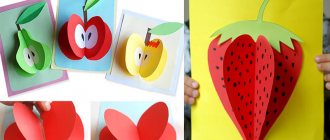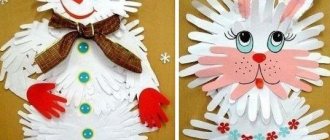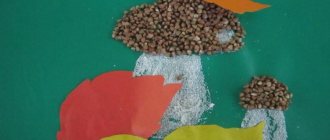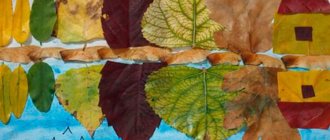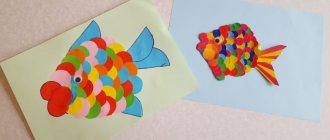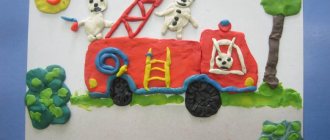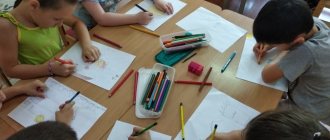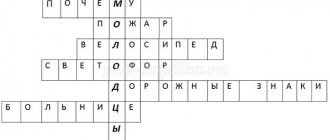Application “Festive round dance” and its modifications
Children of the preparatory group already have sufficient skills and abilities to depict and decorate several round dance figures and independently (or with a little help from the teacher) make a background and additional decor. Developed imagination and fantasy allow preschoolers to conceive and realize the image of round dances with characteristic recognizable details and a variety of central figures. The theme of the round dance depends on the celebration or event that has a significant response in the lives of the children:
- New Year. Animals and snowmen can be involved in the New Year's round dance, and the center of the composition will be an elegant Christmas tree or figures of Father Frost and the Snow Maiden.
Such a funny round dance will arouse children's interest not only in the New Year holiday, but also in winter fun in the fresh air
- Spring. The arrival of spring always brings joy to children, and the students will express their impressions of the spring changes in nature by depicting beauties in folk costumes dancing around a decorated birch tree or in a flower meadow.
- For Children's Day (round dance of friendship, rainbow). It will consist of figures of children from different nationalities of the world in national costumes or simply bright, cheerful clothes, surrounded by balloons, and as the center it is appropriate to use the silhouette of a dove of peace, a rainbow or an image of the globe.
- Autumn. Autumn holidays are celebrated in every kindergarten; this topic is close and understandable to children. The characters in the appliqué can “lead a round dance” around the figure of Autumn in traditional red and gold decoration, and around baskets with her gifts, fruits, mushrooms, and berries.
- National Unity Day. For this holiday, the teacher should invite students to make an applique of a round dance of children in costumes of the nationalities of Russia with the corresponding national symbols.
Fostering patriotism and respect for compatriots will be the main task in creating such a festive round dance.
Whatever the topic of the work, the teacher should remember that children will show interest in it and take an active part in its production only if the preschool institution pays full attention to the solemn event, it is covered in different types of activities (conversations, reading art literature, music classes, etc.).
The “Round Dance” application can be made one of the goals of the project activity; in this case, the theme and design of the work will reflect the theme of the project. For example, at the creative stage of the project “In the World of Fairy Tales,” preschoolers make an applique called “Round Dance of Fairy-Tale Heroes.” And during the project “The World of Objects Around Us”, children will be interested in giving the children of the nursery group a self-made work “Round Dance of Toys, Bears, Matryoshkas”.
Pedagogical guidelines for organizing classes
In the preparatory group, the main goal of the work is to introduce children to beauty, to cultivate love and interest in fine arts and creativity, aesthetics and a sense of color and compositional harmony.
During appliqué classes, children aged 6–7 years cut out paper and glue cut out parts or whole figures. The main artistic means in applique are color and expressiveness of the contour. Silhouette cutting occupies a significant place. An interesting job that develops cutting skills can be transferring a form from life.
The process of evaluating work becomes important in the preschool group. The teacher must teach children to pay attention to shape, color scheme, arrangement of figures, as well as plot and compositional solutions. In addition, such creative analysis develops analytical skills, speech, the ability to express one’s opinion, and outlook. Each lesson should end with an assessment of children's work with the help of leading questions from the teacher.
Preparation for a lesson on a collective application on the theme “Festive round dance”
Thematic variations
An application on the theme “Festive round dance” opens up broad prospects for the manifestation of imagination and creative ideas for both the teacher and the children. The lesson can be timed to coincide with a calendar holiday: Children's Day, National Unity Day. Pedagogical ingenuity will help the teacher come up with holiday events that are not on the calendar: the arrival of spring, the holiday of Russian costume, the holiday of Russian nesting dolls, the holiday of the unification of all the children of the planet. An application on this topic can be either collective or individual. However, collective creativity helps unite the children's team, develop cognitive interest, as well as the desire to achieve a common creative idea and result.
Using different techniques
In the preparatory group, work on this topic is complicated with the help of decoration techniques and the use of traditional and non-traditional appliqué techniques or their creative combination. Depending on the level of general training of the children, the teacher may limit himself to traditional techniques and invite the children to trace a figure using a template and cut it out from a whole sheet of paper or perform a symmetrical appliqué. Non-traditional techniques are an excellent means of developing imagination, inspiration, children's talent and inquisitiveness in creating future masterpieces, not only in appliqué classes. Among the non-traditional techniques that a teacher can use in a lesson on the topic “Festive Round Dance” are the following: quilling (creating compositions from strips of paper swirled in spirals), trimming (can be used as a decoration technique along with symmetrical or silhouette appliqué), appliqué from corrugated paper or fabric.
Design options for the basis for a round dance
The basis for the arrangement of the round dance from children's works is made by the teacher in advance independently, if it will be the subject of a preliminary conversation at the beginning of the lesson, and according to the teacher's plan, the children should not know about the topic of the upcoming lesson. Another option could be to work together with children. The teacher can attract a small group of children of 3-4 people to work together on the workpiece. This type of work can become a logical continuation of a topic that was discussed with the children in other classes, and the children know what lesson they are preparing for and what it is dedicated to.
The basis for placing a round dance from children's works directly depends on the topic of the lesson. Examples include the following ideas:
- “Round dance of friendship” - an image of the globe in the center of a large sheet of paper and a round dance of boys and girls from different countries, in different costumes, of different nationalities. You can add elements of drawing and make prints of colored children’s hands around the round dance.
- “Spring Round Dance” - an image of a Spring girl in a bright green sundress, a wreath of the first spring flowers in the center of a large sheet of paper, and a round dance of girls in decorated sundresses. Can be complemented with flowers and butterflies made of corrugated paper.
- “Round dance of Russian beauties” - an image of Russian birch trees on a sunny day (you can use non-traditional drawing or appliqué techniques) and a round dance of girls in Russian sundresses.
- “Winter has come” - an image of a Christmas tree covered with snow, in the center of a light blue tinted paper, and around there is a round dance of snowmen. You can make snow on the Christmas tree using the cutting appliqué technique.
- “Golden Autumn” is an image of an Autumn girl in a golden sundress, decorated with the gifts of nature - leaves, berries - in the center of a large sheet of paper and around a round dance of girls in yellow, orange and red sundresses, decorated with autumn motifs or according to the children's design. You can decorate the remaining space with the help of falling leaves, using different drawing or applique techniques (for example, dry leaves from a herbarium).
Techniques and materials used to make applique
In the preparatory group, children deepen and improve the skills acquired earlier, consolidate the ability to use and combine various materials in applications. They can make figurines of round dance heroes either independently or together with their peers (in pairs or subgroups of 4–6 people). If the child works alone, the most successful option would be ribbon appliqué, when figures are cut out of accordion-folded strips of paper measuring 25–30 cm by 10–15 cm.
Each of the variants of this application can be performed by a child of the seventh year of life.
Interaction in pairs and subgroups requires preschoolers to be able to agree and divide the amount of work. The teacher will help them with this, but the techniques used should be simpler. Children can cut out silhouettes using a template from a whole or folded sheet of paper, glue them around the center, and then work together to make and glue the pieces. They are performed using the following application techniques:
- Invoice. Some elements are cut out and glued, sometimes not along the entire perimeter, but on one side, which creates a volume effect that is more realistic. This way you can attach sleeves, character hats, serpentine on a New Year's background, ribbons on a spring birch tree.
- Proreznaya. Using this technique, elements are made that attract attention and serve as decoration for the entire composition, for example, sundresses and kokoshniks of young ladies, and national costumes. First, a one-color silhouette of the character is glued onto the sheet, then the face (overlay technique), headdress and clothes are added. Drawings for cutting are applied to parts of a contrasting color using a simple pencil using a stencil or template, then everything is combined into one composition.
- Collage. Pre-prepared fragments are pasted onto the general background: clippings from magazines, children's books that have fallen into disrepair.
This work combined two techniques: slotting and tape
Both collage and cut-out appliqué are complex techniques that require attention and painstakingness, so making a composition using them is best divided into two classes: in the first, the background is prepared and simple silhouettes are pasted, in the second, they are supplemented with decorative elements.
Also in the design of works they use modular techniques (composing images from geometric shapes) and mosaic, when the outline or silhouette is filled with scraps of paper according to the mosaic principle. It is possible to combine appliqué with drawing, inviting children to draw characters’ faces, patterns on clothes, small decorative details (confetti, flowers, leaves). Sometimes paper parts made using the design technique fit well into the composition. So, a creative solution would be to make sundresses for dancing girls from a strip of paper folded into a fan.
If you combine applique and paper design, you will get original, interesting works.
Since the goal of visual activity in the preparatory group is to produce works of artistic value, then for appliqué it is necessary to take high-quality, bright, decorative materials. In addition to ordinary colored paper in attractive pure tones, the following are used:
- Candy wrappers, scraps of wrapping paper with prints and glitter.
- Textiles, that is, ribbons, chintz, tulle, chiffon.
- Sequins, industrial sets of small elements for decorating crafts (snowflakes, stars, flowers). These elements are difficult to attach using PVA glue, which is approved in kindergartens, so it is better to choose adhesive-based decor.
- Natural material (leaves, twigs of dried flowers).
Even from such waste material as candy wrappers, a creative teacher can come up with elegant dresses for princess dolls
MAGAZINE Preschooler.RF
Summary of GCD Topic: “Round dance of the Russian nesting doll”Municipal budgetary preschool educational institution Kindergarten “Lastochka”
(preparatory group)
Prepared by: teacher Ermolaeva Nina Vasilievna, music director Petukhova Tatyana Alekseevna. Taiga
Software tasks:
Educational:
- To introduce children to the perception of decorative and applied arts through music and drawing;
- Introduce the Semyonovskaya matryoshka doll;
- To consolidate the ability to use non-traditional drawing techniques when painting nesting dolls.
Educational:
- Develop aesthetic perception and imagination;
- To develop children's creative and creative abilities.
Wellness:
- Monitor children's posture while working.
Educational:
- Foster respect for the work of folk craftsmen.
Methods: Game, visual, verbal, practical.
Techniques: examination of an authentic toy - a nesting doll, an algorithm, a conversation, a literary word, a riddle, ditties, a physical exercise, explanations, encouragement, independent activity of children, the use of various techniques for drawing, getting into character.
Material and equipment:
Demonstration: Matryoshka toy, algorithm, easel.
Handout: paper stencils of nesting dolls, gouache paint in red, blue, green, wet wipes, cotton swabs.
Equipment: screen with nesting doll appliqué.
Musical accompaniment: stereo system, audio cassette with Russian folk music.
Vocabulary work: use in speech the words of the definitions of Semenovskaya Matryoshka (cheerful, joyful, painted, souvenir, black-browed...) with Maxim U., Ramil H.. Enrich the children's vocabulary with words: souvenir, paint, chain of buds.
Individual work: help struggling children with painting.
Preliminary work: examination of objects of decorative and applied art, mini-exhibition in kindergarten, reading literary words about Russian crafts.
Progress of the lesson:
The Russian folk melody “There was a birch tree in the field” . Against the background of music...
Educator: Hello, children, hello!
I brought a wondrous wonder today. A wonderful, painted wonder. Well, guess. What it is?
(makes a riddle)
There is one toy for you, not a horse, not Parsley. Scarlet silk scarf, Bright floral sundress,
The hand rests on the wooden sides. And there are secrets inside: Maybe three, maybe six. Got a little flushed
Our…
(Children's answers - Russian nesting doll)
Of course, this is Matryoshka! What a joyful toy! Legends are made about her, as well as about folk heroes. Our Matryoshka is known and loved all over the world - not a single tourist will leave Russia without a souvenir doll.
How old do you think Matryoshka is? (children's answers) It turns out that she turns 120 this year. With great diligence, the first nesting doll was made by hand by master toy maker Vasily Petrovich Zvezdochkin (shows photo), and artist Sergei Vasilyevich Malyutin painted it. This is how a wooden figurine in a Russian sundress was born. One of the artists exclaimed: “Matrona is good!” So the wooden figurine was called Matryona, or affectionately – Matryoshka. There are different Matryoshka dolls.
What is a nesting doll made of? Children's answers: Made of wood. Matryoshka dolls are made from wood. Educator: What kind of wood?
Children's answers: From birch. Matryoshka dolls are made from Christmas trees. They make nesting dolls from linden.
Educator: Making a matryoshka doll is not easy. Look at the algorithm, how it is made.
(work according to algorithm)
Educator: What does the master do first?
Children's answers: At the beginning of the work, the master selects a block of wood.
Selects a block of wood to begin work.
The master selects a block of wood from which he will make a matryoshka doll.
Educator: Then he turns the workpiece on a lathe so that there is no knot or crack. Then it is made detachable. What's next?
Children's answers: Prepare paints for work.
Prepare the paints needed to paint the matryoshka doll.
The artist selects paints of the color that he needs. Then he paints the matryoshka doll.
Educator: What does he do when he has painted a matryoshka doll?
Children's answers: Covers it with varnish for strength.
To make the nesting doll durable, it is coated with varnish.
To prevent the matryoshka from deteriorating, it is coated with a shiny, colorless varnish.
Educator: So our cheerful Matryoshka is ready. This nesting doll is from the city of Semenov, so its name is... (Semyonovskaya)
What colors do artists use in painting?
Children's answers: Artists use red, blue, green.
For their work, artists use different colors: red, yellow, black, blue.
In painting, artists use bright, rich colors of different colors.
Educator: How is Matryoshka’s apron painted?
Children's answers: She is holding a large bouquet of roses in her hands.
There are a lot of leaves in the bouquet.
It covers almost the entire apron.
Educator: How is the handkerchief painted?
Children's answers: The edges are decorated with a chain of buds and leaves.
Along the edge of the scarf there is a chain of flower buds and leaves.
Along the border of the scarf, leaves and flower buds are drawn in a chain.
Educator: What do you think Matryoshka could be like?
Children's answers: Cheerful and mischievous.
Playful, joyful.
Festive, kind, affectionate.
Elegant, souvenir, etc.
Educator: Matryoshka became a great traveler. Starting your journey around the world from the city of Semenov. Do you like Semenov's nesting doll? Would you like to paint it?
(obtains children's consent)
Educator: Then I invite you to the factory for painting Semenov’s nesting dolls. How can you paint Matryoshka?
Children's answers: You can paint it with your finger.
The matryoshka can be painted using a “poke” and a cotton swab.
Colored and pastel pencils and paints will help when painting the nesting dolls.
You can paint with a feather or signet.
(The teacher offers physical training)
Physical exercise.
Before you draw, you need to stretch your fingers. Index and middle, ring and last
We said hello to the big one. Now let’s rub our palms together a little. Fists unclenched - clenched,
The fists unclenched and clenched. So we stretched our fingers. And now, masters, it’s time for everyone to get to work.
(Russian folk melody “And I’m in the meadow” . Children independently paint Matryoshka dolls)
Masters, get to work quickly. Decorate the nesting dolls with confidence. Choose any pattern so that it pleases the eye.
(During the painting, the teacher reminds the children of proverbs about work.
If you hurry, you will make people laugh. Good work lives for two centuries. Skillful hands do not know boredom. The sun paints the earth, and labor paints man.
As is the master, so is the work. Every master's work is beautiful.
After completing the painting, he gives a summary)
Well done! Very beautifully painted. Real master artists!
And the nesting dolls themselves are master craftsmen: elegant beauties, singers, and dancers.
Today is a holiday in our house, Guests are clapping their hands. The acquaintance continues. Where are you, nesting dolls?
(Matryoshka dolls run out to the music)
Hey, Matryoshka-laughing dolls, start singing ditties!
(Children sing ditties to a Russian folk melody)
1. We are nesting dolls, we are girlfriends, We get up early in the morning, The four of us sing ditties and the four of us dance.
2. And we don’t need cribs, Because at night we sleep together, we sleep together, we all sleep in one another.
3. The girlfriends were walking along the path, There were only a few of them: Two Matryonas, three Matryoshkas and one Matryoshka.
4. Oh, Matryosha’s Daughter is so pretty! The daughters are beautiful, they look like her!
5. I am a Matryoshka - a souvenir In painted boots, The Russian Matryoshka thundered throughout the world!
6. The master carved me out of a piece of birch, How rosy am I: Cheeks like roses.
7. Our Russian nesting doll does not age for a hundred years! The secret lies in beauty, in Russian talent.
8. Our Russia is great, and our people are talented. About our native Rus', the rumor spreads all over the world.
(The Russian folk melody “There was a birch tree in the field” . Against the background of music...)
Educator: Many years have passed, but Matryoshka is still the favorite toy of children. She decorates our apartments. They willingly give it to friends as a good memory. But the essence of the Russian Matryoshka remains the same - love and friendship.
Literature.
- Averyanova A.P. Visual activities in kindergarten (classes). Mosaic – Synthesis, 2001.
- Alekhin A.D. Matryoshka dolls. Picture book. Moscow Malysh Publishing House, 1988.
- Komarova T.S. Folk art in the education of preschool children Moscow. Pedagogical Society of Russia, 2005.
- Skorolupova O.A. Introducing preschool children to Russian folk arts and crafts. Moscow. Scriptorium, 2003.
- Solomennikova O.A. The joy of creativity. Moscow. Mosaic-synthesis, 2005.
- Alekhin A.D. Matryoshka dolls. Picture book. M. Publishing house "Malysh" , 1988.
- Berestov V.D. Matryoshka nursery rhymes. Book-toy. Publishing house "Malysh" M. 1982.
- Tufkreo R., Kudeiko M. Collection of ideas. Moscow. Linka-Press, 2004.
- Nikitina A.V. Non-traditional drawing techniques in kindergarten. St. Petersburg KARO, 2007.
- Edited by Kazakova R. G. Drawing with preschool children Non-traditional techniques, lesson scenarios, planning. Moscow. Creative Center Sphere, 2004.
| Next > |
How to make a background for the “Festive round dance” applique
Careful preparation of the background is no less important than the production of the main elements of the application. First of all, you need to think about how the background will be combined with the image on it. If you plan to make a multi-colored, colorful round dance, then the background for it should be chosen in pastel colors with a minimum of additional decorations. If you want to make the figures in a round dance schematic, one or two colors, then a bright, rich background with large, catchy elements (sun, Christmas tree, globe) is appropriate. In any case, you shouldn’t overload the work with decorating, since we not only strengthen children’s skills and abilities, but also cultivate a sense of proportion and artistic taste in preschoolers.
Unusual, fabulous backgrounds are obtained if you use the technique of spraying gouache on dark paper
As a background you can use:
- Wallpaper with patterns and plain colors.
- Thick fabric of discreet colors, soft checks, stripes.
- Paper with additional application of paint by spraying, stamps, roller, wet-on-wet tinting, imprint from polyethylene painted with gouache or watercolor (monotype).
The preparation of the background includes the image of minor elements (trees, houses, sun, clouds, etc.). This can be done in the afternoon, allotted for independent visual activity. Children take a direct and active part in the preparation; some types of work can be entrusted to them completely, such as tinting on wet paper with sponges and watercolors, drawing with pencils, stamps, scratching on gouache-painted cardboard.
Decorating a background with a monotype is a complex process, but the result is always pleasing and fascinating, creating a festive mood
Motivating preschoolers to study
Usually the theme of the holidays does not leave children indifferent, but in order to broaden their horizons and increase cognitive activity, the teacher should use interesting information, for example, talk about the traditions of celebrating the New Year, the harvest festival in the old days, in other countries.
In addition, it is advisable to use the following techniques:
- Appeal to children's experience. The preparers will readily remember past holidays, share their impressions of them, of changes in nature in autumn and spring, talk about their participation in the harvest, spring walks, matinees, and folk festivals. Such memories will serve as an incentive for visual activity.
- Reading literary works, folklore, conversation based on their content. There are many poems, round dances and ritual songs that will be of interest to future schoolchildren, and the applique can be made based on them.
Conversations about round dancing are another reason to attract children’s attention to the wonderful traditions of the people
- Setting a socially useful goal. The psychology of older preschoolers differs from that of younger children in that it is no longer enough for children to simply draw and glue; they want their works to have practical benefits. If the teacher not only invites the children to make a composition, but gives them the idea to decorate the locker room, kindergarten hall with it, or prepare a colorful panel as a gift for younger students, the children will perceive this with great enthusiasm and will show much more diligence and interest than usual. Naturally, the work must be used exactly as it was announced to the children.
- A surprise or game moment. The group receives a package containing details of folk costumes. Children are invited to dress up in them and learn an ancient round dance game. For example, “Grey Little Bunny”, “Scarlet Flower”. Noisy and very active games at the motivational stage are inappropriate, because after them children are excited and their attention is scattered.
- The arrival of a character who first offers to make an applique, and then plays a round dance game with the children (high mobility is also possible).
- Showing illustrations, reproductions of paintings, listening to folk round dance songs in audio recordings.
Preschoolers can be introduced to a picture in which adults also participate in a round dance, which will significantly expand their understanding of ancient rituals and fun
Conducting a lesson on application on the topic “Festive round dance”
Direct educational activity (lesson) in the preparatory group lasts 30 minutes; in the middle there is certainly a physical education session to relieve tension, finger exercises, and a game of low or medium mobility.
Table: structure and duration of lessons on application in the preparatory group of a preschool educational institution
| GCD stage | Duration of the stage |
| Introductory part. Organizing children, creating a positive mood. | Up to 2 minutes. |
| Main part. A surprise or game moment. Motivation for visual activities. Introductory conversation, showing the teacher how to do the work. Safety briefing. Finger gymnastics, physical education. Carrying out work by children. | Up to 25 minutes. |
| Final part. Summing up by the teacher, questions for the children. Children's assessment of their activities and mood. Review and discussion of works. | Up to 3 minutes. |
When planning a lesson, the teacher first of all determines for himself the range of program objectives that need to be achieved. Depending on the materials and techniques used, these tasks differ somewhat, since different skills are consolidated and practiced (cutting out accordion-folded paper, tracing and cutting out an image along a contour, composing an image from geometric shapes, etc.). But there are also tasks common to all classes: the development of fine motor skills, the skills of careful and economical use of glue, the consolidation of the ability to arrange the details of an image on the plane of a sheet, the cultivation of artistic taste, interest in folk traditions, love for the native land and its nature.
Performing the “Round Dance” application develops a sense of color and composition, teaches the child to do the work slowly
Not only the program objectives of the lesson depend on the chosen technique, but also the algorithm for performing the work and explaining its stages to children. It is necessary to think through the instructions in advance in order to convey them to the students as simply and clearly as possible.
Table: algorithms for making appliqués using various techniques
| Applique technique | Execution algorithm |
| Tape |
The teacher should remember that only the thinnest colored paper is suitable for such an applique, otherwise children will not be able to cut it by folding it in three. |
| Silhouette + slotted |
|
| Modular |
|
Preparatory work is of great importance, which includes designing from paper, experimenting with this material, and observing the teacher make similar products outside of class. It starts in middle school and continues in the senior group.
Children are given the opportunity to play with paper folded like an accordion, unfold it and fold it again along the finished folds, tear off strips, and see what happens. When making New Year's garlands to decorate the group, the teacher demonstrates what will happen if you cut the joints on the folds, and what will happen if you don't. Thus, when starting work, older preschoolers already imagine its result and can control their actions, and not just passively follow instructions. If the group has a computer, children are offered to watch video instructions, which will undoubtedly arouse great interest.
Video: making a round dance from paper
Self-analysis and reflection of children at the final stage of the lesson
Children in the preparatory group are quite capable of assessing the activities of both themselves and their comrades, analyzing them and drawing conclusions. To encourage preschoolers to analyze, the teacher asks them questions, for example:
- What was easy to do that caused difficulties?
- What do you think needs to be changed next time to make work easier and more interesting?
- What new materials can be used to decorate a new round dance?
- Did you get the job done, did you work hard, did you do well?
Questions should stimulate creative, imaginative thinking and at the same time strengthen the child’s self-confidence and instill respect for his comrades and their work. To make the lesson analysis truly effective, the teacher should take note of several children’s ideas expressed during the lesson and implement them in subsequent artistic activities.
Self-analysis and assessment of work in class
Children in the preparatory group must evaluate their own actions every lesson. When studying at school, elements of self-analysis in the classroom will not be new for them, but a familiar and natural activity. Questions for reflection include:
- What did you succeed in the lesson?
- What didn't work?
- Would you like me to help you fix your mistake?
- Did you like the lesson?
- What can you be praised for in this lesson?
- Were you great today? (It is imperative to convince the child of a positive answer. Whatever the real results of the preschooler’s activities in the classroom, he is always great and smart; this must be emphasized and reinforced in the minds of every student).
Successful activities stimulate preschoolers to new research and discoveries
Of course, the teacher adjusts the course of the assessment activity so that all children ultimately feel comfortable, experience joy from the activity in the lesson and satisfaction from its result. Creating a “success situation” encourages children to engage in new activities with interest and enthusiasm.
